Silver Bridge Collapse Memorial
Introduction
Text-to-speech Audio
Images
This historical detailing the history of the collapse was placed in 2006.
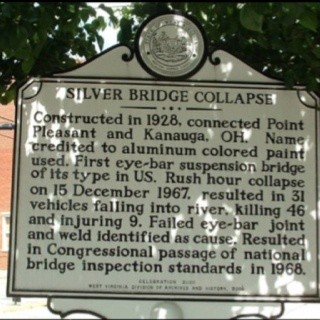
The bridge was the first of its kind when it was completed in 1928.
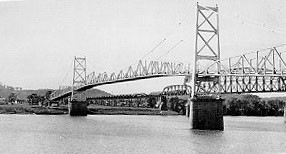
The bridge after it collapsed, as seen from the Ohio side of the river.
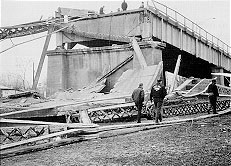
Cross above the Silver Bridge Dedication Plaque
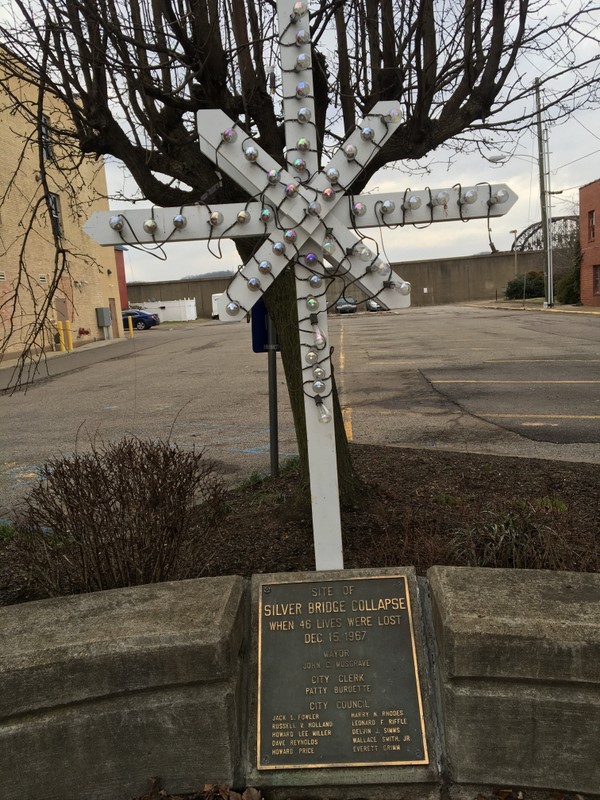
In 2018 a mural depicting the Silver Bridge was painted on the floodwall in front of the memorial. Image obtained from the Historical Marker Database.
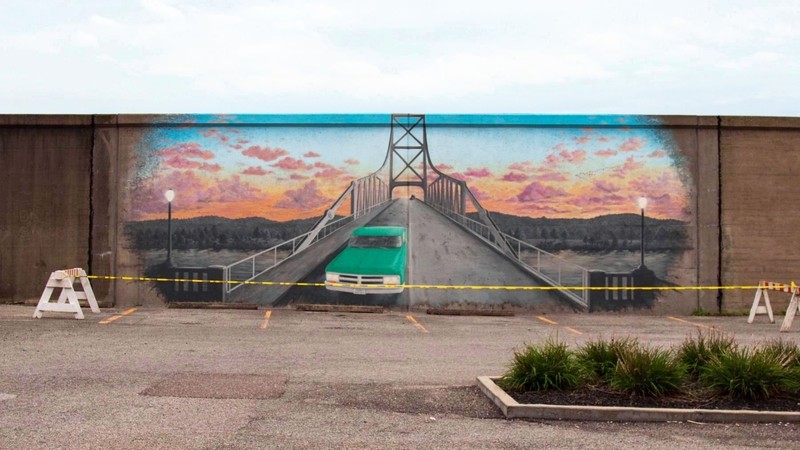
A Replica of the eyebars used in the Silver Bridge.
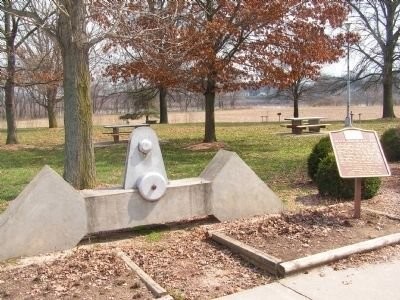
In 1928 Engineer Charles Vogel (Left) and George Cumpston (Center) were the first two people to cross the Silver Bridge in a vehicle after its construction.
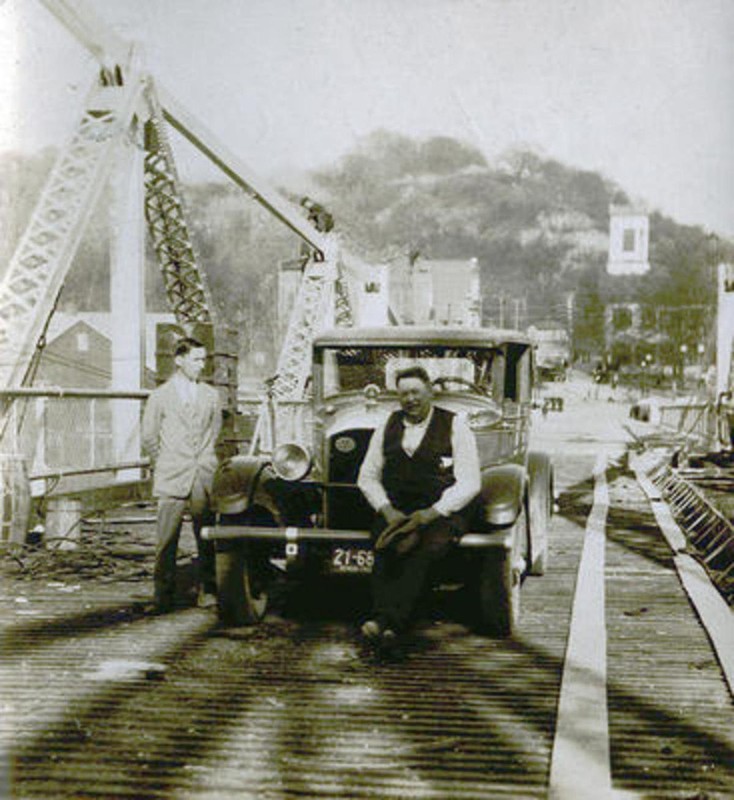
Backstory and Context
Text-to-speech Audio
The idea for a bridge connecting Pt. Pleasant, West Virginia and Gallipolis, Ohio was said to have originated with Charles Holzer, a doctor who claimed that the long time it took to get across the Ohio River jeopardized the lives of his patients. During the 1920s Holzer began rallying support for a bridge, which resulted in the creation of the West Virginia Ohio River Bridge Company. It soon commissioned the American Bridge Company, a subsidiary of U.S. Steel, to build the bridge. Construction began in 1926 and was completed in 1928 at a cost of around $1.2 million. The two-lane, 2,235 foot-long suspension bridge was one of the first in the United States to utilize an eyebar design. Rather than using conventional wire cables for its suspension, the bridge instead used chains of eyebars, which were more affordable. The bridge was also reportedly the first in the nation to be built with heat-treated steel, which made it more durable. The bridge officially opened to the public on Memorial Day, May 30, 1928, in a ceremony attended by 10,000 people. It was formally named the Pt. Pleasant Bridge, but immediately began being referred to as the Silver Bridge due to its distinct aluminum-colored paint.
The Silver Bridge soon became an economic lifeline for the communities of Pt. Pleasant and Gallipolis. Large numbers of goods and travelers crossed the bridge between Ohio and West Virginia every day, significantly reducing travel times. The bridge was privately owned and supported by toll fees until 1941 when the State of West Virginia purchased it for $1 million; the toll fees were removed a decade later. The bridge underwent a series of renovations in 1941, including the replacement of the original wood plank road with a new concrete road. Inspections of the bridge’s structural integrity were infrequent, reportedly occurring only in 1959, 1963, 1964, and twice in the summer of 1967. Over the decades the bridge underwent increasing strain as the weight and number of cars crossing jumped enormously beyond the standards of the 1920s.
At around 4:58 PM on Friday, December 15, 1967, the Silver Bridge abruptly collapsed. Eyewitnesses reported a strong shake and a loud noise, and within twenty seconds the bridge fell into the Ohio River. 31 vehicles were on the bridge when it fell. Rescue efforts were hampered by the extreme cold and darkness; sunset occurred just ten minutes after the collapse. In total 46 people were killed and nine injured; of those who were on the bridge when it fell, only five survived. It was the worst vehicular bridge collapse in American history. A federal investigation later revealed that the collapse was caused by a single fractured eyebar, exacerbated by corrosion and stress, which had broken.
The collapse of the Silver Bridge was devastating to the local economy, costing the community $1 million a month in damages. Because of this, the federal government rushed the construction of a new bridge one and a half miles south of the original. The Silver Memorial Bridge opened just two years later in 1969. In addition to a federal investigation, the collapse also pushed the government into passing bridge safety legislation. The twin bridge in St. Marys, West Virginia, was built to a similar design of the Silver Bridge and as a result of the push for bridge saftey, it was closed to the public, and demolished by the state in 1971. The Presidential Task Force on Bridge Safety was established, a national bridge inventory was created, and an amendment was added to the Federal-Aid Highway bill of 1968 mandating that bridge inspections be conducted at least every two years. It was also recommended that the Federal Bridge Saftey Standards be applied to all highway bridges in the country rather than just the federally built ones, this would total to around 400,000 bridges.
The investigation into the cause of the collapse blamed no one for the tragedy, noting that under the standards and knowledge of the 1920s, the conditions for the bridge’s collapse were not known to occur in rural areas. In the years since, however, some locals have cited paranormal reasons for the incident. Early theories suggested that Chief Cornstalk, the Native American leader defeated at the Battle of Pt. Pleasant in 1774, had placed a curse on the community as he died. A more well-known idea has been that the local mythical creature Mothman was somehow behind the collapse; Mothman sightings were reported and publicized multiple times in the year leading up to the tragedy. The theory was later popularized by a 1975 novel The Mothman Prophecies, which was later adapted into a 2002 film.
Today a small memorial to the collapse exists where the Pt. Pleasant on-ramp entrance to the bridge once stood. It consists of a small plaque noting the significance of the site, as well as a series of paving bricks listing the names of the 46 victims. A historical marker was erected beside the site in 2006. In 2018 a mural was painted on the floodwall in front of the site depicting the Silver Bridge. The painting features a 1928 model vehicle and a 1967 model, representing the years of the bridge’s birth and death.
Sources
Brumage, Jody. “The Legacy of the Collapse of the Silver Bridge.” Robert C. Byrd Center for Congressional History and Education. December 12, 2017. Accessed November 2, 2018. https://www.byrdcenter.org/byrd-center-blog/the-legacy-of-the-silver-bridge-collapse
Harold, Zack. “Silver Bridge tragedy still haunts river city residents.” Charleston Gazette-Mail. December 11, 2012. Accessed November 2, 2018. https://www.wvgazettemail.com/news/silver-bridge-tragedy-still-haunts-river-city-residents/article_8ff26265-d1ff-5fc0-976a-090d6ca8fc75.html
OpenLearn from The Open University. “The Silver Bridge disaster” (video). September 10, 2009. Accessed November 2, 2018. https://www.youtube.com/watch?v=dGQfUWvP0II
LeRose, Chris. “The Collapse of the Silver Bridge.” West Virginia Historical Society Quarterly 15, No. 4 (October 2001). Accessed November 2, 2018. http://www.wvculture.org/history/wvhs/wvhs1504.html
Prats, J. J. “Silver Bridge Collapse.” The Historical Marker Database. October 15, 2018. Accessed November 2, 2018. https://www.hmdb.org/marker.asp?marker=124202
“Remembrance ceremony to mark 50th anniversary of Silver Bridge collapse.” West Virginia MetroNews Network. December 13, 2017. Accessed November 2, 2018. http://www.wvmetronews.com/2017/12/13/remembrance-ceremony-to-mark-50th-anniversary-of-silver-bridge-collapse/
Sergent, Beth. “Mural to bring the Silver Bridge back to 6th Street.” Point Pleasant Register. January 4, 2018. Accessed November 3, 2018. https://www.mydailyregister.com/top-stories/22721/mural-to-bring-the-silver-bridge-back-to-6th-street
Sergent, Beth. “Silver Bridge survivor remembers.” Point Pleasant Register. December 22, 2017. Accessed November 2, 2018. https://www.mydailyregister.com/top-stories/22408/silver-bridge-survivor-remembers
“Silver Bridge.” West Virginia Department of Transportation. Accessed November 2, 2018. https://transportation.wv.gov/highways/bridge_facts/Modern-Bridges/Pages/Silver.aspx
“Silver Bridge Disaster.” Charleston Gazette. December 16, 1967. Accessed November 2, 2018. http://www.wvculture.org/history/disasters/silverbridge04.html
Steelhammer, Rick. “Fifty years later, effects of Silver Bridge disaster still felt.” Charleston Gazette-Mail. December 9, 2017. Accessed November 2, 2018. https://www.wvgazettemail.com/news/fifty-years-later-effects-of-silver-bridge-disaster-still-felt/article_28fae06f-3669-5bca-9957-66bfc2d03ab4.html
WCPO.com | 9 On Your Side. “Silver Bridge collapse” (video). February 19, 2013. Accessed November 2, 2018. https://m.youtube.com/watch?v=4SJ4lj-FZcg
Witcher, T. R. “From Disaster to Prevention: The Silver Bridge.” Civil Engineering (December 2017). Accessed November 2, 2018. https://www.asce.org/uploadedFiles/CE_Magazine/Home_Page/Content_Pieces/2017-12-history-lesson--original.pdf
WVDOT. “50th Anniversary of the Silver Bridge Collapse” (video). December 15, 2017. Accessed November 2, 2018. https://m.youtube.com/watch?v=ErntxB0nLHcSilver Bridge.Silver Bridge. West Virginia Department of Transportation. . Accessed June 30, 2019. https://transportation.wv.gov/highways/bridge_facts/Modern-Bridges/Pages/Silver.aspx.
